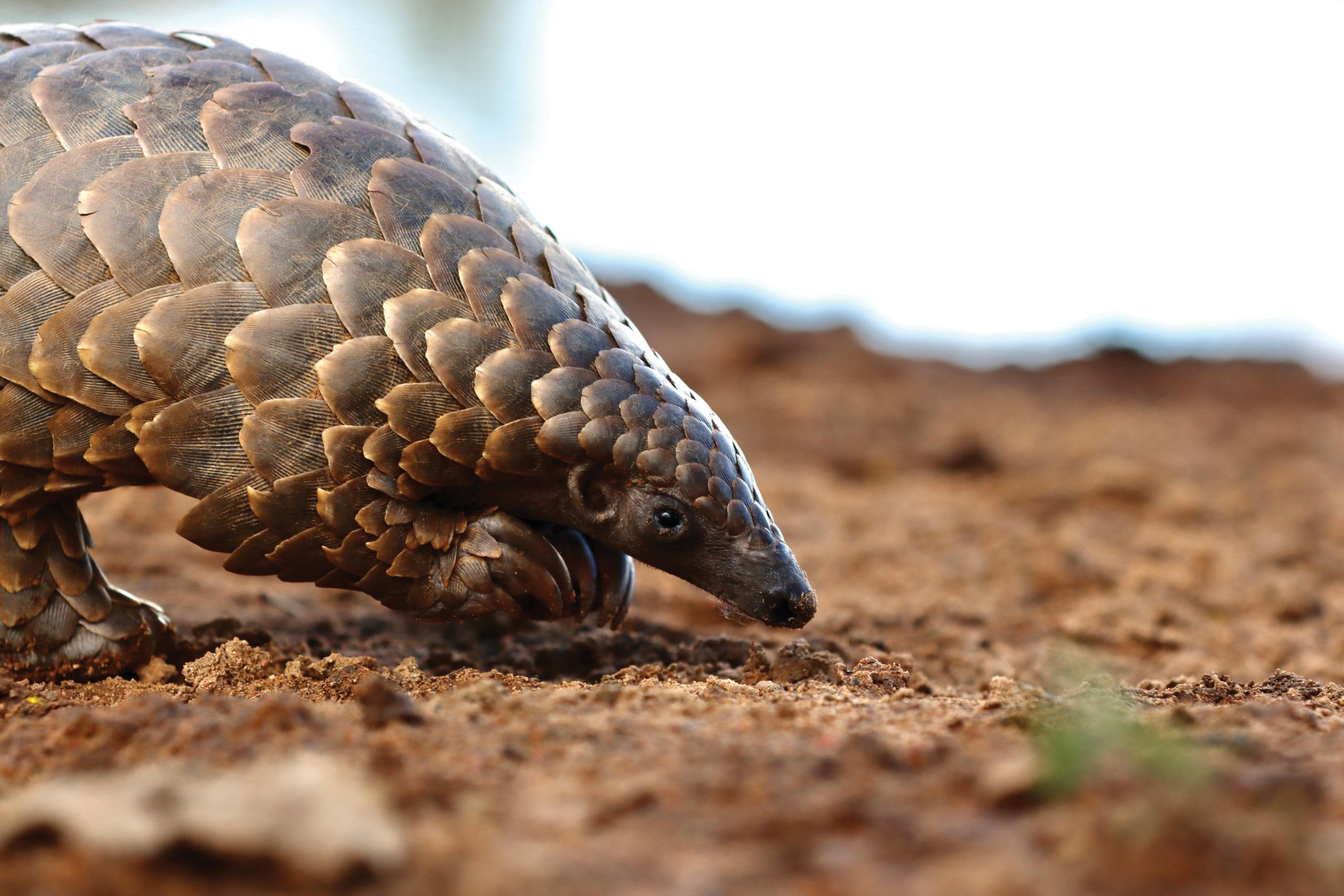
Miss Namibia 2025: Johanna Swartbooi
Johanna Swartbooi of Vaalgras is crowned Miss Namibia 2025 in a dazzling finale held in northern Namibia – a celebration of beauty, purpose and national pride, with a journey set to inspire.

By Elzanne McCulloch
When the sun sets over Namibia’s vast landscapes, a secretive creature emerges from its burrow. Covered in scales that glisten under the moonlight, it moves with careful precision, seeking out a meal of termites. This is the pangolin – one of the world’s most enigmatic animals and, alarmingly, the most trafficked mammal on the planet. Despite their vital ecological role, pangolins remain largely misunderstood and underprotected. But one organisation is working tirelessly to change that.
The Pangolin Conservation and Research Foundation (PCRF), headed by Kelsey Prediger, was born out of necessity. Kelsey saw an alarming gap in pangolin protection efforts in southern Africa. With established conservation entities focusing elsewhere and little research available on the species, she knew something had to be done.
“I wanted to create an organisation that was not just about protecting pangolins but about empowering conservationists to step up and become champions for these animals,” she says. Her journey into pangolin conservation was unexpected – having worked primarily with carnivores, she found herself drawn to a species few were studying. “When I discovered pangolins were the most trafficked mammal in the world and that almost no research had been done in Namibia, I knew this was the conservation challenge I needed to take on.”
Establishing the PCRF, however, was no small feat. Conservation is an uphill battle, and gaining credibility, funding, and public trust proved to be some of the greatest hurdles. “Building a reputation and securing funding is still one of our biggest challenges,” she admits. “Learning how to run an NGO is a completely different skill set from field research – you have to approach it like a business to make it sustainable.”
Pangolins have roamed the Earth for over 50 million years, surviving dramatic shifts in climate and landscapes. But their greatest threat has only emerged recently– humans. In southern Africa, pangolins face relentless poaching, illegal trafficking, and the deadly consequences of modern infrastructure.
“These animals are especially vulnerable because their primary defense is to curl into a ball,” she explains. “While this protects them from natural predators, it makes them easy targets for poachers.” In Namibia, additional threats include climate change and habitat destruction. Severe droughts have led to food scarcity, as pangolins rely on very specific ant and termite species. Without access to these food sources, many starve.
One lesser-known but increasingly devastating threat is electric fencing. A growing number of pangolins are being electrocuted by low-lying electric fences, often unnoticed. “These fences were designed to keep larger animals in or out, but they are inadvertently lethal to pangolins. They walk right into the bottom wires and get trapped, suffering a slow and tragic death,” Kelsey explains. Studies in South Africa suggest that for every 11 km of electric fencing, at least one pangolin dies each year– a number that could be even higher in Namibia.
Despite these challenges, Namibia provides a unique opportunity for pangolin conservation. “We have vast, open spaces and a low human population density, meaning this country could be a stronghold for the species.” But that requires proactive conservation strategies, education, and strong legal protections.
Since its inception in 2020, PCRF has made remarkable strides in pangolin conservation. Working in collaboration with Namibia’s Ministry of Environment, Forestry, and Tourism, they have rescued and released 35 pangolins. Their Nyae Nyae Pangolin Project – a research initiative combining community engagement with scientific tracking – has empowered local communities to become pangolin guardians.
“We work closely with local people, training and employing pangolin guardians who act as the first line of defense against poaching,” she explains. In a powerful example of the project’s success, a community 200 kilometers away from the research site intervened when a traditional hunter attempted to kill a pangolin. “They told him, ‘That’s our pangolin. If you kill it, we’ll report you to the police,’ because they understood the conservation and economic value of protecting these animals. That was a beacon of hope for us.”
For conservation to be effective, it must be rooted in science. The foundation’s research has already led to critical breakthroughs in pangolin rehabilitation and rewilding. One of the most important discoveries has been the significance of food and burrows over water availability when releasing rescued pangolins. “Healthy pangolins can survive without drinking water, but they need immediate access to food and shelter,” she notes. “This insight helped us update Namibia’s pangolin release guidelines to improve survival rates.”
Technology is also playing an increasing role. The foundation is developing AI-based pangolin detection for camera traps and incorporating bioacoustic monitoring to track biodiversity. In addition, advancements in radio transmitter technology have allowed for more affordable and efficient monitoring of pangolin movements post-release. “We’re working on making tracking devices smaller, longer-lasting, and more cost-effective so we can follow pangolins without disturbing their natural behavior,” Kelsey adds.
One of the biggest victories for pangolin conservation in Namibia has been the shift in public awareness and law enforcement. Thanks to increased training, over 300 law enforcement officers are now equipped with the knowledge to properly handle, transport, and release pangolins. The Blue Rhino Task Team – a special anti-poaching unit – has also strengthened sentencing for pangolin trafficking crimes. “More people are realising that pangolins are worth protecting,” she says. “We’ve even heard traffickers say they wouldn’t touch a pangolin because they know how serious the penalties are.”
Despite these wins, pangolin poaching remains a significant problem. “Unlike rhinos and elephants, pangolin poaching leaves no carcasses behind. They’re simply taken. This makes it incredibly difficult to track trends.” Between 2018 and 2023, 570 pangolins were poached and linked to official cases – more than the combined number of elephant and rhino poaching cases in the same period.
Conservation is a collective effort, and FlyNamibia has played a role in supporting PCRF’s mission. Recently, FlyNamibia sponsored a flight to Katima Mulilo to aid in the search for a missing tagged pangolin. Despite facing challenges – including rough terrain and a high density of elephants in the tracking area – the team gathered critical insights into pangolin movement and survival in the wild. Currently, PCRF is in need of an additional field vehicle to make post-release monitoring and rehabilitations work achievable. Potential sponsors are welcome to contact them.
“FlyNamibia’s support allows us to reach remote areas where pangolins need protection the most,” Kelsey acknowledges. “Every bit of support truly makes a difference.” As efforts to protect pangolins continue, partnerships like these highlight how businesses and conservationists can work together for a sustainable future.
Learn more or support: pangolincrf.org

Johanna Swartbooi of Vaalgras is crowned Miss Namibia 2025 in a dazzling finale held in northern Namibia – a celebration of beauty, purpose and national pride, with a journey set to inspire.

The Day of the African Child honours past struggles while calling for stronger planning and investment in children’s rights – shaping a future where every child in Namibia and across Africa can thrive.

Elisia Nghidishange weaves tradition, material memory and contemporary themes into powerful mixed media works – exploring human connection while nurturing creativity in her rural Namibian community.

Namibian artisans are transforming cultural heritage into market-ready craftwork through EU-supported training – preserving tradition, inspiring creativity and building a more sustainable, inclusive economy.